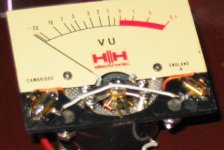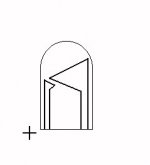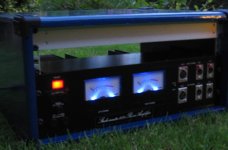what are those tiny light bulbs in VU meters? What voltage/current. AC? DC where can you buy them?
I bought an old piece of kit and I thought it was just blown bulbs. I've replaced the bulbs from meters salvaged from an old HH mixer, but a previous owner had dismantled the light circuit!
I bought an old piece of kit and I thought it was just blown bulbs. I've replaced the bulbs from meters salvaged from an old HH mixer, but a previous owner had dismantled the light circuit!
Attachments
At a guess they're probably wire-ended lamps like RS stock code 339-0457. I'm pretty sure Maplin sell something similar but their website is down right now.
My guess is they will be 2x6V light bulbs wired in series and powered from a 12V line somewhere in the amp. The bulbs should run on either AC or DC, RS suggests they last longer running on AC but they may well have been DC powered.
My guess is they will be 2x6V light bulbs wired in series and powered from a 12V line somewhere in the amp. The bulbs should run on either AC or DC, RS suggests they last longer running on AC but they may well have been DC powered.
Karma, your link does not work. 
Jaycee, they are not wire ended. the contacts are brass wrapped around the side. They clip into the holders sideways. The piece of circuit that remains is a big resistor, (I forgot to note the value) and one lead connected directly to The neutral mains tag of the power switch (240v in the uk). The other end is gone.
I'd love to contact the makers of either piece of kit, but both Studiomaster and HH are long dead. Coincidently (or not?) one was in Cambridge, the other, in Hoddesdon. The Towns are 30 miles apart connected by the A10 main road.
Blue LEDs are starting to look attractive
Jaycee, they are not wire ended. the contacts are brass wrapped around the side. They clip into the holders sideways. The piece of circuit that remains is a big resistor, (I forgot to note the value) and one lead connected directly to The neutral mains tag of the power switch (240v in the uk). The other end is gone.
I'd love to contact the makers of either piece of kit, but both Studiomaster and HH are long dead. Coincidently (or not?) one was in Cambridge, the other, in Hoddesdon. The Towns are 30 miles apart connected by the A10 main road.
Blue LEDs are starting to look attractive
Hmm.. sounds like they were connected directly over the mains.This is a bad idea, in audio, as the VU's will be connected to the analog amplifier stage, you really don't want 50Hz mains near signal wiring!
See if you can find some suitable low voltage supply, 12V or so, inside the equipment, then wire 2 6v meter bulbs in series per meter to the supply. Or use LED's of any colour of your choice with the appropriate dropper resistor - white LEDs would work pretty well.
See if you can find some suitable low voltage supply, 12V or so, inside the equipment, then wire 2 6v meter bulbs in series per meter to the supply. Or use LED's of any colour of your choice with the appropriate dropper resistor - white LEDs would work pretty well.
Hmmmmmmmmmmmmmmmm I agree!
I went looking for some 12 volt DC. This thing runs at 120VDC! I don't know how. I once posted a thread about "why cant you run with rectified mains and ditch the transformer" But was told its dangerous and we don't allow such descussions here. This looks pretty close!
I once posted a thread about "why cant you run with rectified mains and ditch the transformer" But was told its dangerous and we don't allow such descussions here. This looks pretty close!
Anyway I think the plan is to make a low volt supply. One question though. LEDs run at 5V (no?). Why did you say 12V? Can you suggest a way to drop down from 120v (or 60V if I tap off one of the PSU caps)?
I went looking for some 12 volt DC. This thing runs at 120VDC! I don't know how.
 I once posted a thread about "why cant you run with rectified mains and ditch the transformer" But was told its dangerous and we don't allow such descussions here. This looks pretty close!
I once posted a thread about "why cant you run with rectified mains and ditch the transformer" But was told its dangerous and we don't allow such descussions here. This looks pretty close!Anyway I think the plan is to make a low volt supply. One question though. LEDs run at 5V (no?). Why did you say 12V? Can you suggest a way to drop down from 120v (or 60V if I tap off one of the PSU caps)?
LEDs do not "run" at a voltage as such. The only requirement is that the current flowing through them is kept to a low level, typically 15mA or so. LED's have a voltage drop, so you work out the resistor by ohm's law as follows - (Vsupply-Vdrop/current)
As for it running at 120VDC, it's probably more likely that it runs at +-60VDC and you're measuring across the rails. Is this some kind of high power amp ?
As for it running at 120VDC, it's probably more likely that it runs at +-60VDC and you're measuring across the rails. Is this some kind of high power amp ?
Sorry, I don't design electronics. I just build the stuff. This particular beast is an old Studiomaster slave amp that is rated at 200W per chan into 4ohm.
The blue LED at maplin are listed as max foward voltage 5V. A silicon diode drops 0.6V so :
12-(0.6V X 2)/2 X 30mA = 170 ...say 200ohm?
I COULD just use a voltage divider to get to 12V or get close and use a voltage reg chip.
The blue LED at maplin are listed as max foward voltage 5V. A silicon diode drops 0.6V so :
12-(0.6V X 2)/2 X 30mA = 170 ...say 200ohm?
I COULD just use a voltage divider to get to 12V or get close and use a voltage reg chip.
you might try tracing the circuit. I drove myself nuts trying to find replacement lamps for an amp once that appeared to have 100V lamps (the front end regulated supply voltage.) There was a series resistor that drops it down to 12V when the lamp draws current. It won't show with a voltmeter's high impedance.
I just dropped in a 12 volt lamp since it was the only thing I could find in that "grain of wheat" style. But I don't recomment the "see if it blows up method."
Instead, you might also try putting a 1W 10K ohm resitor in place of the lamp and see if the voltage across it drops - a good sign that there is a resistor upstream. If there isn't a resistor upstream you'll see over a watt dissipation, so this should be a measure the voltage quickly and power down so you don't smoke the resitor test.
If it really is 120 Volts across the lamp, you'll need a lot more than 200 ohms in series to keep your LED alive. You want to keep the current below 30 mA, the max for the LED. The resistor(s) will need to drop 115 volts (120 - 5V dropped in the LED) V/I=R, you can do the math. A little more resitance can be used to dim the LED if desired. Used 20 K in my modified A75 (130 Volts cross the regulated rails), and a low output led (300 mcd) - it is still too bright. Don't forget to size your resitors properly - calculate the dissipated power, and add a safety factor.
good luck.
I just dropped in a 12 volt lamp since it was the only thing I could find in that "grain of wheat" style. But I don't recomment the "see if it blows up method."
Instead, you might also try putting a 1W 10K ohm resitor in place of the lamp and see if the voltage across it drops - a good sign that there is a resistor upstream. If there isn't a resistor upstream you'll see over a watt dissipation, so this should be a measure the voltage quickly and power down so you don't smoke the resitor test.
If it really is 120 Volts across the lamp, you'll need a lot more than 200 ohms in series to keep your LED alive. You want to keep the current below 30 mA, the max for the LED. The resistor(s) will need to drop 115 volts (120 - 5V dropped in the LED) V/I=R, you can do the math. A little more resitance can be used to dim the LED if desired. Used 20 K in my modified A75 (130 Volts cross the regulated rails), and a low output led (300 mcd) - it is still too bright. Don't forget to size your resitors properly - calculate the dissipated power, and add a safety factor.
good luck.
I am now starting to doubt everything I ever knew.
*Do 2 LEDs in series double the forward voltage? I'm running off the 60V rail through 2 30mA LEDs. (60-5V)/0.60 = >1000R.
*LEDs light when you connect the annode to positive?
*Looking into an LED, the anode is the stick and the cathode is the flag?
Well I did that and nothing! I measure 40mA current flow. The 1K res is getting hot. I measure 1.3 V across both diodes.
*Do 2 LEDs in series double the forward voltage? I'm running off the 60V rail through 2 30mA LEDs. (60-5V)/0.60 = >1000R.
*LEDs light when you connect the annode to positive?
*Looking into an LED, the anode is the stick and the cathode is the flag?
Well I did that and nothing! I measure 40mA current flow. The 1K res is getting hot. I measure 1.3 V across both diodes.
Attachments
2-3k is a better number (don't add the currents for series connections)
try turning the leds around
edit
the two leds in series or parallel?
I think in practice a blue led drops about 3.6v 5V is the max figure
20ma ea is a better current
try turning the leds around
2-3k is still a better number
try turning the leds around
edit
the two leds in series or parallel?
I think in practice a blue led drops about 3.6v 5V is the max figure
20ma ea is a better current
try turning the leds around
2-3k is still a better number
HA!
Finally got the damm things to work. I found a short. Up they came. I used a 2K resistor. I'm a little worried that a 2W resistor gets almost too hot to touch. I'll back it off with a 3K, but I wonder what this is doing to the power supply. I would hate for this to be the cause of clipping at high power.
Finally got the damm things to work. I found a short. Up they came. I used a 2K resistor. I'm a little worried that a 2W resistor gets almost too hot to touch. I'll back it off with a 3K, but I wonder what this is doing to the power supply. I would hate for this to be the cause of clipping at high power.
should be fine led's take verry little to power up. nothing your power supply would notice at high volume
at high volume
hopefully thay outlast the amp good luck
post a pic
p.s
if the resister run's a little warm make sure it's not touching the
clear plastic on the meter over time it may turn brown from the heat. if it's anywarez around it.
hopefully thay outlast the amp good luck
post a pic
p.s
if the resister run's a little warm make sure it's not touching the
clear plastic on the meter over time it may turn brown from the heat. if it's anywarez around it.
VU LED conclusion
I was asked for a photograph. Sorry that there is a little camera shake. I could only take pix in the half light. They really do light the meters well........ with the bonus that they really stand out.
Well if you're going to make a show...
Thanks guys.
I was asked for a photograph. Sorry that there is a little camera shake. I could only take pix in the half light. They really do light the meters well........ with the bonus that they really stand out.
Well if you're going to make a show...
Thanks guys.
Attachments
- Status
- This old topic is closed. If you want to reopen this topic, contact a moderator using the "Report Post" button.
- Home
- Amplifiers
- Solid State
- VU light bulbs?


